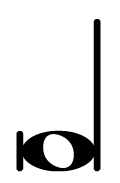Longa (music) on:
[Wikipedia]
[Google]
[Amazon]
A longa (pl. ''longae'', or sometimes ''longe''), long, quadruple note (Am.), or quadruple whole note is a  . In this context it is sometimes called a quadruple whole note. In
. In this context it is sometimes called a quadruple whole note. In
musical note
In music, a note is the representation of a musical sound.
Notes can represent the pitch and duration of a sound in musical notation. A note can also represent a pitch class.
Notes are the building blocks of much written music: discretizatio ...
that could be either twice or three times as long as a breve
A breve (, less often , neuter form of the Latin "short, brief") is the diacritic mark ˘, shaped like the bottom half of a circle. As used in Ancient Greek, it is also called , . It resembles the caron (the wedge or in Czech, in S ...
(Am.: double whole note, or double note), four or six times as long as a semibreve
A whole note (American) or semibreve (British) in musical notation is a single note equivalent to or lasting as long as two half notes or four quarter notes. Description
The whole note or semibreve has a note head in the shape of a hollow ov ...
(Am.: whole note), that appears in early music
Early music generally comprises Medieval music (500–1400) and Renaissance music (1400–1600), but can also include Baroque music (1600–1750). Originating in Europe, early music is a broad musical era for the beginning of Western classi ...
. The number of breves in a long was determined by the "modus" or "mode" of a passage. Sections in perfect mode used three breves to the long while sections in imperfect mode used two breves to the long. Imperfect longs, worth two breves, existed in perfect mode from the earliest sources (late 12th century), while the fourteenth century saw the introduction of perfect longs, worth three breves, in imperfect mode through the use of dots of addition (''puncti additiones'').
Prior to the innovations of Franco of Cologne in the mid-thirteenth century, the value of the longa was in common usage in both theoretical and practical sources but appeared primarily in pre-mensural notation ligatures, symbols representing two or more notes joined together. A ligature that began with a longa was said to lack "propriety", while ligatures ending with a longa possessed "perfection", since in the view of that era a "proper and perfect" rhythmic sequence was the succession of a brevis followed by a longa, justified by the fact that the ligature representing this rhythm is written the same way as a plainchant ligature (a different usage of the term from above). As a result, there were four possible ligature types: those beginning with a ''brevis'' and ending with a ''longa'', which had both propriety and perfection; the reverse, which had neither; those both beginning and ending with a ''longa'', which lacked propriety but had perfection; and those beginning and ending with a brevis, which were proper but not perfect. Two longae, rarely three, had the combined value of a '' maxima''. The theoretical value of a ''maximodus perfectus'' could only be written with three longae or a ''maxima'' plus a ''longa''.
Prior to 1450, the ''longa'' was typically written with a filled notehead with void (unfilled) and red noteheads used only to indicate an imperfect longa where perfect longae would otherwise be expected. Over the course of the fifteenth century, the void notehead (shown in the image above) became the norm. Unlike other rests used in ensural notationwhich, like the notes, took the same form whether perfect or imperfect, ''longa'' rests often had different forms when the rest was imperfect—filling two spaces—or perfect—filling three spaces. Although it is described as late as 1667, by this date the note symbol was of purely theoretical interest, since changes in notational practice had rendered it too extended a value for practical use.. While the ''longa'' note has not been used for more than three centuries, the ''longa'' rest still appears as a way of writing rests that last exactly four measures.
When the ''longa'' note occurs in modern notation (since it is supported by some scorewriter
A scorewriter, or music notation program is software for creating, editing and printing sheet music. A scorewriter is to music notation what a word processor is to text, in that they typically provide flexible editing and automatic layout, and p ...
s), it is often given the rounded notehead shape of the double whole note, looking like LilyPond
LilyPond is a computer program and file format for music engraving. One of LilyPond's major goals is to produce scores that are engraved with traditional layout rules, reflecting the era when scores were engraved by hand.
LilyPond is cross-pla ...
, the longa stem appears similarly to that of a half note
''Half Note'' is a live album by saxophonist Clifford Jordan which was recorded in 1974 and first released on the SteepleChase label in 1985.
, instead of always appearing on the right of the notehead as it does in mensural notation: this can be seen below.
See also
*List of musical symbols
Musical symbols are marks and symbols in musical notation that indicate various aspects of how a piece of music is to be performed. There are symbols to communicate information about many musical elements, including pitch, duration, dynamics, ...
References
*Further reading
* * {{DEFAULTSORT:Longa (Music) Latin words and phrases Note values